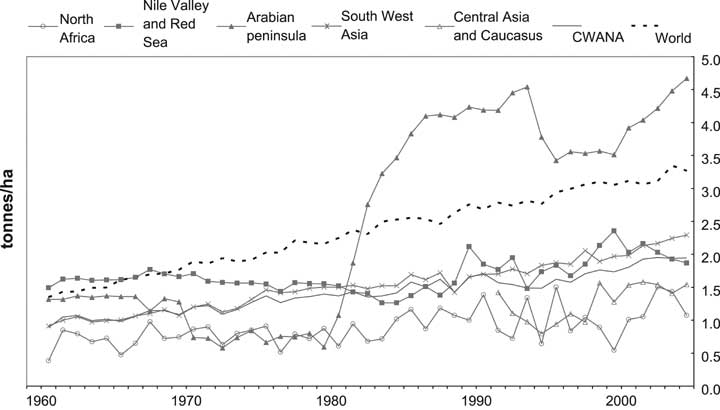
| Previous | Return to table of contents | Search Reports | Next |
| « Back to weltagrarbericht.de | ||
Historical and Current Perspectives of AKST | 31

Figure 2-1. Cereal yield in CWANA, 1961-2005. Source:
FAOSTAT database, data for CAC countries
are not available for the whole period
|
yield. When rainfall is adequate, these countries still have low yields. Increases the last 50 years have been limited (1960-1965: 0.7 tonnes ha-1 to 2000-2005: 1.2 tonnes ha-1) (Latiri, 2005). In some Mediterranean countries, irrigation allows a more stable yield and increases have been observed since the early 1970s. In the Nile Valley and Red Sea countries, cereal production increased due to area and yield increases from 8.9x106 tonnes in 1960-1965 to 26.3x106 tonnes in 2000-2005. In the Arabian Peninsula, the area under cereals increased, but is still minimal: 0.7x106 ha. Yields are above the world average because of irrigation. In CAC countries yields are about 1.9 tonnes ha-1, but some countries, like Uzbekistan, have experienced regular increases the last few years. Like animal products, grains production fluctuated greatly in Central Asia and the Caucasus. Economic liberalization had a destabilizing effect in the early 1990s but this situation has shown recovery since the early 2000s. 2.1.2.2 Maize, legumes and industrial crops Maize and rice are the most important irrigated crops. Oil crops, such as groundnut, sunflower and sesame are significant. Cotton is an important irrigated crop in most of Central Asia, covering over 3.8x106 ha. The most important legumes in the region are chickpea, lentil and dry beans. West Asian countries have been known for their pulses for a long time. Most pulses originate from Mesopotamia. The total share of South Asia and West Asia in the average pulse production in CWANA was 73% in the 2000s, with Turkey, Pakistan and Iran standing out as the most important producers. Egypt and Sudan in the Nile Valley and Red Sea subregion and Morocco in the North African subregion are also important producers. International demand for pulses has had a positive effect on volume and productivity Their area increased by about 50% and yield increased from 0.62 to 0.87 tonnes ha-1 during the last 50 years. This production increase was mainly in Southwest Asia. |
Legumes could play a major role in rainfed systems. About 30 million ha of land is left fallow in CWANA every year. If 70% of this land could be sown with forage legumes, it could produce enough to feed 80 million sheep. Moreover, there would be 1.4x106 tonnes of nitrogen added from symbiotic nitrogen fixed each year. Sugar beet and sugar cane are mainly produced in Southwest Asia, comprising 8.5% of world production. In the other subregions, production increased but is still low. North Africa increased from 0.1 to 1.5% and Nile Valley from 0.1 to 1.2% of world production from the 1980s to today. Sugar beet is an industrial crop highly supported by government policies in CWANA and in other parts of the world. Subsidies, until the 1990s, increased volume and productivity. Facilities offered to producers for storing and transporting their crops had significant results on the production and marketing of the sugar beet in West Asian and North African countries. Since the mid-1990s production volumes fell because of agricultural policy changes. Most of the sugar refining units were public enterprises that have gone private. Tunisia gave up its sugar industry, judging it more expensive to produce its own sugar than to import it. Most of the sugar beet farms converted to raising livestock. In Turkey, the government continues to subsidize beet production, but the changes in transportation patterns, including the switch from rail to truck transportation, diminished the willingness of the farmers to cultivate sugar beet. Many switched to other crops. Nevertheless, Turkey stands out as the largest sugar beet producer in CWANA, followed by Iran, Morocco, Egypt and Syria. Production in CWANA has increased, while the overall world production of sugar beet has decreased since 2000. 2.1.2.3 Horticultural and vegetable crops Horticulture and vegetables also exist in the cropping systems in the region. Potatoes, tomatoes, grapes, almonds, apples, olives and oranges are the most important crop |
| Previous | Return to table of contents | Search Reports | Next |
| « Back to weltagrarbericht.de | ||